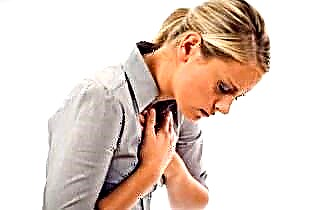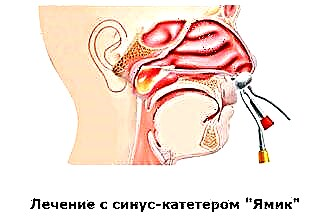The presence of the larynx gives a person the ability to breathe, speak, sing, swallow, and eat. The anatomy of an organ is a cavity lined with muscle tissue, the mobility and efficiency of which is given by cartilage. The internal structure is complemented by the vocal cords. The blood supply is carried out through its upper and lower arteries. It is the connecting link between the pharynx and the trachea and forms the upper part of the vocal tube.
Larynx structure
 The throat is responsible for a number of functions. Oxygen circulating in the cavity tube from the contraction of the muscle tissue of the pharynx, as well as the lingual and oral muscles, changes the size and shape of the cavity, thereby stretching the vocal cords. As a result, a person, controlling the air flow flowing through the laryngeal cavity, produces articulate sounds called speech. In this case, more than 15 vocal muscles are involved.
The throat is responsible for a number of functions. Oxygen circulating in the cavity tube from the contraction of the muscle tissue of the pharynx, as well as the lingual and oral muscles, changes the size and shape of the cavity, thereby stretching the vocal cords. As a result, a person, controlling the air flow flowing through the laryngeal cavity, produces articulate sounds called speech. In this case, more than 15 vocal muscles are involved.
In addition, the larynx, vocal muscles and ligaments affect the pitch and timbre of the voice. If the voice becomes hoarse over time, this means that the ligaments have lost their firmness and elasticity. Cartilage is vital to the functioning of the musculoskeletal system.
The larynx is designed in such a way that its components are interconnected. These are membranes, ligaments, joints, cartilage, which are considered the immediate base of the cavity, called the larynx, and also perform a connective function, uniting together the cavity, the hyoid muscles, the thyroid gland and the respiratory organs.
The construction is a skeleton of paired and unpaired cartilage.
Unpaired laryngeal cartilages:
- Cricoid cartilage got its name from its shape in the form of a ring. This is a plate, called a ring or tapered arc, facing forward. As already noted, it acts as a link between the trachea and the original cartilaginous ring, where the lower part is directed towards the trachea, and the upper part lies parallel. At the edge of the plate, unpaired cartilages are connected with the help of joints
- Thyroid cartilage - the largest cartilage of the larynx in the form of two large plates, combined at an angle, called the Adam's apple. The plates are symmetrical. The kadik is felt through the skin layer. Its presence is assumed not only in men, but also in women and children, but it is not so pronounced. At the bottom of the thyroid cartilage there is a small notch, and behind the plates thicken and pass into processes, which are called the upper and lower horns. The outer horn connects to the hyoid bone, and the inferior thyroid cartilage is in contact with the cricoid cartilage. In addition, the laryngeal artery passes through the thyroid cartilage.
- The supraglottic cartilage is called the throat gate. It is located on top of the thyroid cartilage. It resembles a leaf of a tree in shape, respectively, the bottom is a stalk, the top is a leaf.

The paired ones include:
- arytenoid cartilage, which resembles an irregular pyramid with three faces, and which joins the cricoid cartilage through joints. The laryngeal muscles and vocal cords are also attached here. This is the “apparatus” of human speech.
- cartilaginous cartilages, which are cone-shaped, are located at the base of the arytenoid cartilage and act as a connecting link.
- the wedge-shaped cartilage, located on top of the carob-shaped pair, covers the pharyngeal entrance when swallowing.
The cartilage of the larynx is fastened together by joints and ligaments in the frame of membranes. The vocal cords and cartilage begin to function when air moves, setting the vocal apparatus in motion.
Cartilage movement is regulated by the anterior muscles of the neck. These muscles change the position of the epiglottis cartilage when breathing, speaking, swallowing. In general, the structure of the larynx is responsible for reproducing speech, musical sounds and ensuring the activity of the vocal apparatus.
Diseases
Throat ailments are inflammatory, allergic and infectious. The most famous are:
 Acute laryngitis is an inflammation of the larynx mucosa. The disease occurs for two reasons: external (irritants are gas, dust, various chemicals) and endogenous (weak immunity, allergies). It is common knowledge, for example, about the mutation of the voice in adolescence in boys. Bacterial flora can be a serious development factor.
Acute laryngitis is an inflammation of the larynx mucosa. The disease occurs for two reasons: external (irritants are gas, dust, various chemicals) and endogenous (weak immunity, allergies). It is common knowledge, for example, about the mutation of the voice in adolescence in boys. Bacterial flora can be a serious development factor.- Infiltrative laryngitis, characterized by acute bacterial infection of the larynx, ligaments, perichondrium, muscular apparatus as a result of infectious diseases or injuries.
- Angina affecting the lymph nodes.
- Throat edema is a secondary inflammation in allergic reactions, causing pathology of the mucous membrane and narrowing of the larynx.
- Idiopathic edema, progressing under the influence of acute infections and burns of the respiratory tract.
Treatment
Important reasons for the weakening of the function of the ligaments are considered:
- viral infection;
- overvoltage;
- psychological trauma and stress overload;
- chemical exposure.
Throat therapy directly depends on the provoking factors and the clinical picture of the disease. In most cases, the voice is restored on its own, no medical intervention is required.
In clinical otolaryngology, a number of main methods of treatment are distinguished:
 elimination of irritant, allergen;
elimination of irritant, allergen;- treatment of the inflammatory process of the pharynx (tonsillitis, pharyngitis, flu);
- silence for some time to relieve tension on the vocal cords;
- warm milk;
- medical preparations;
- vitamin therapy.
If the disease is chronic, urgent consultation with an otolaryngologist is required. Self-medication is not recommended. Taking care of your health, preventive measures, rejection of bad habits, adherence to the daily regimen, rational rest and sleep, timely diagnosis of the disease will help to maintain the vigor and vitality of your body for a long time.
Childhood diseases
The development of symptoms of inflammation of the larynx in children at the initial stage is rapid and acute, due to pronounced edema and immaturity of the larynx. In such a situation, the child is capricious, his breathing becomes noisy, resembles snoring, there may be attacks of suffocation. In emergency cases, a lack of oxygen provokes irreversible processes in the brain and leads to coma. Urgent hospitalization and active drug therapy are required.
Traditional methods of treatment
 With the inflammatory process of the cartilage of the larynx, alternative medicine can also come to the rescue. It should be noted that treatment with folk remedies does not have such a quick result as the use of drugs, but it takes a certain place in the choice of means and the achievement of the effectiveness of treatment.
With the inflammatory process of the cartilage of the larynx, alternative medicine can also come to the rescue. It should be noted that treatment with folk remedies does not have such a quick result as the use of drugs, but it takes a certain place in the choice of means and the achievement of the effectiveness of treatment.
Pain Relief Recipes:
- Mix propolis tincture with honey 1: 1. Treating the tonsils.
- Chop the onion. Cover the resulting gruel with sugar (half a glass). After a day, squeeze out the juice. The resulting syrup is taken three times a day, a tablespoon.
- Chamomile flowers, calendula, chop, pour dill. The ratio is 1: 1: 2. Insist half an hour. Strain. Rinse twice a day.
- Add five to ten drops of basil oil to a glass of warm water and rinse three times while awake for five days.
- Combine the leaves of black currant, walnut and chicory in equal proportions. Pour boiling water over. Leave for a couple of hours. Take half a glass 4 times a day.
- Crush three cloves of garlic and pour in a glass of warm milk. Insist and drink in small sips.
- Mix plantain leaf juice with honey 1: 1. Put on low heat for 5-7 minutes. The infusion should be taken in several sips three times a day.
- Boil 20 grams of white raisins in 250 ml of water. Add a spoonful of onion juice.Reception: half a glass three times a day.
- Squeeze the beet juice into a container. Add a spoonful of apple cider vinegar. The reception rate is the same.
- Gargle with regular salt.
- Drink tea with lemon and honey.
 An ancient method of treatment with kerosene, which has a warming and antibacterial effect. Add 40 drops of lighting kerosene to a mug of warm water. Gargle with infusion after each meal.
An ancient method of treatment with kerosene, which has a warming and antibacterial effect. Add 40 drops of lighting kerosene to a mug of warm water. Gargle with infusion after each meal.
At the same time, official medicine advises to treat treatment with herbs and beekeeping products with great caution. For example, honey and propolis are both strong allergens.
It is generally accepted that the body can overcome any causative agent of the disease on its own, but this is an erroneous opinion. The body's defense response is able to effectively fight certain types of viruses and bacteria. Even if the immune system is in good health. Watching movies about casinos, it is impossible not to identify the picture of Sharpshooters in the list of the best. There are a lot of advertisements on the Internet and on television about unrealistically steep wins in any gambling club. Pin Up Casino is one of the best casinos in the opinion of players, but you can find out if this is so at http://obzory-kazino.com.ua/kazino-pin-up/, this review was compiled by experts from all over the world. Its main element is still the very familiar bright and catchy logo with the letter "L" stylized as a volcano. It all depends on the financial situation of the club and its fairness.
Antibiotics for treatment
Medicines of this type are prescribed only by the attending physician. Self-medication can lead to extremely negative consequences.
The choice of an effective antibiotic is the task of the attending physician, which is solved during the examination of the patient and on the basis of laboratory diagnostics.
What is chondroperichondritis of the larynx
A disease in which the perichondrium and cartilage, receiving nutrients from it, become inflamed. Infectious agents always act as provocateurs of this process.
Clinical symptoms of chondroperichondritis: hoarseness, chills, cough, increased neck volume.

If you do not seek qualified help in a timely manner, such a laryngeal edema can lead to serious consequences, it may even be fatal. The acute form of the course of the disease provokes the overlap of the respiratory gap, as a result of which there is a restriction of air admission, which leads to asphyxia. But even the timely provision of first aid does not insure against the appearance of cicatricial changes in the tissues of the larynx, which entails the onset of disability.
When only the perichondrium is infected, the following therapy is performed:
- the use of antibacterial drugs;
- taking glucocorticosteroids;
- UV irradiation;
- compresses.
If this does not bring the expected result, surgical intervention is required to eliminate necrotic tissue from the surface of the perichondrium, localize the sources of pus and drain it for its release.
Be healthy! Do not be ill! Take care of yourself!

 Acute laryngitis is an inflammation of the larynx mucosa. The disease occurs for two reasons: external (irritants are gas, dust, various chemicals) and endogenous (weak immunity, allergies). It is common knowledge, for example, about the mutation of the voice in adolescence in boys. Bacterial flora can be a serious development factor.
Acute laryngitis is an inflammation of the larynx mucosa. The disease occurs for two reasons: external (irritants are gas, dust, various chemicals) and endogenous (weak immunity, allergies). It is common knowledge, for example, about the mutation of the voice in adolescence in boys. Bacterial flora can be a serious development factor. elimination of irritant, allergen;
elimination of irritant, allergen; An ancient method of treatment with kerosene, which has a warming and antibacterial effect. Add 40 drops of lighting kerosene to a mug of warm water. Gargle with infusion after each meal.
An ancient method of treatment with kerosene, which has a warming and antibacterial effect. Add 40 drops of lighting kerosene to a mug of warm water. Gargle with infusion after each meal.

